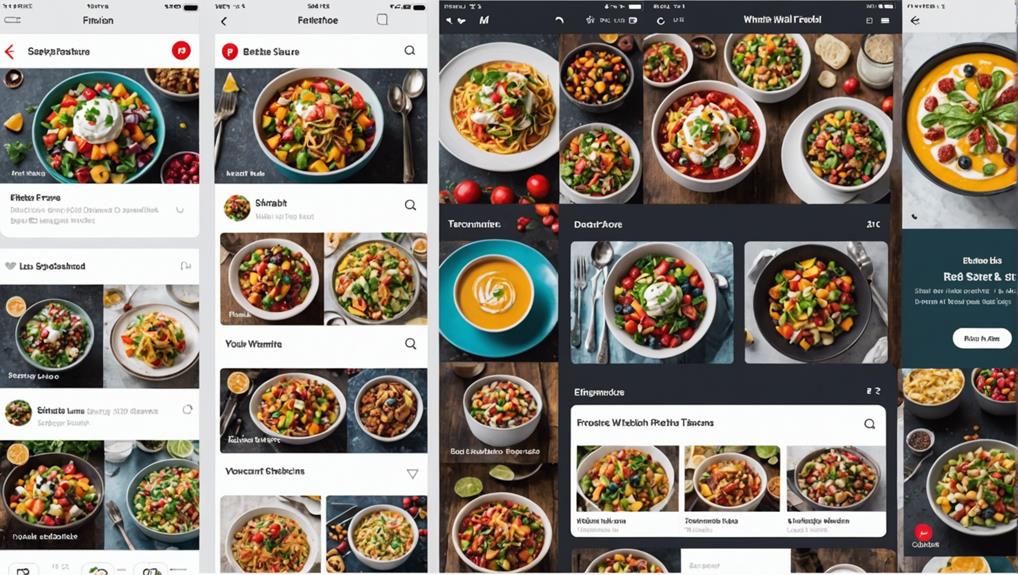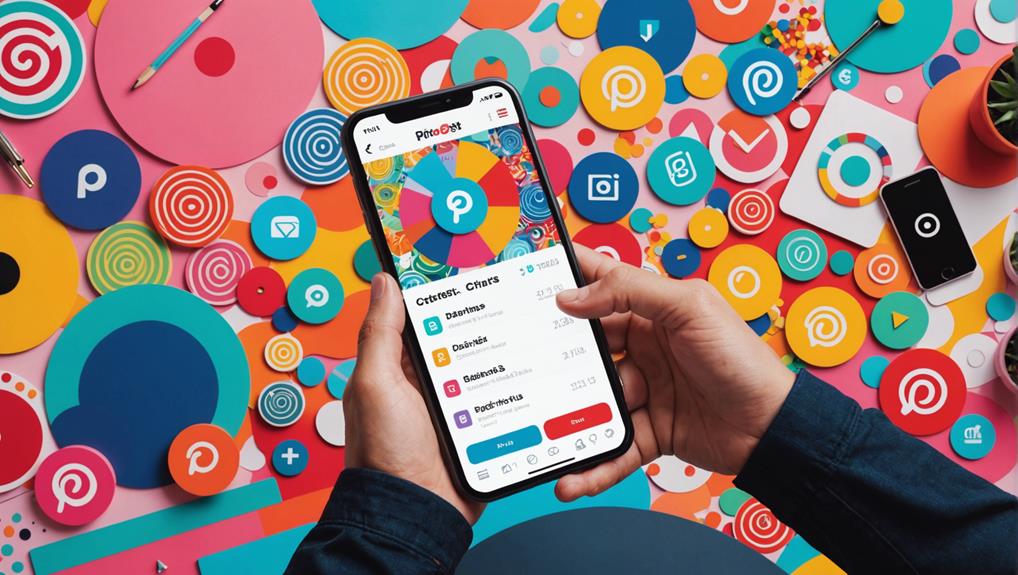Using Pinterest group boards can greatly boost your reach. You'll access a larger audience beyond your followers and increase engagement. Start by searching for niche-specific boards and review their collaborators and engagement levels. When joining, tailor your request to show alignment with the board's content. Once in, engage actively by pinning, commenting, and supporting fellow members. Convert to a Pinterest business account for insights and schedule pins using tools like Tailwind. Regularly analyze performance and refine your strategy to optimize visibility. By following these steps, you'll strategically amplify your Pinterest presence. Discover more strategic tips and advanced techniques…
Key Takeaways
- Join niche-specific group boards to target the right audience and increase content visibility.
- Craft personalized join requests to align your content with the group's focus and increase acceptance chances.
- Actively pin and engage with other contributors' content to foster a sense of community and collaboration.
- Use advanced analytics from a Pinterest business account to track performance and optimize your pinning strategy.
- Follow each group board's pinning guidelines to maintain compliance and enhance your reach within the community.
What Are Pinterest Group Boards?
Pinterest Group Boards are collaborative spaces where multiple users can share and contribute pins, helping you reach a wider audience beyond your personal followers. Created by a single user, these boards allow you to invite others to join as contributors, enabling a dynamic exchange of ideas and content. This collaborative nature makes understanding and practicing group board etiquette essential. Be respectful of the board's guidelines and make sure your pins are relevant and high-quality to maintain a positive community environment.
Collaboration strategies are key to maximizing the benefits of group boards. Engage actively by pinning regularly, commenting on others' pins, and fostering a sense of community. This approach not only enriches the board's content but also enhances your visibility and engagement. Following pinning guidelines specific to each group board ensures your contributions align with the board's theme and quality standards, fostering a cohesive and appealing collection of pins.
Community engagement is fundamental. By participating in discussions and supporting fellow contributors, you cultivate relationships that can lead to further collaborative opportunities. Strategically using group boards can greatly amplify your Pinterest reach, making them an invaluable tool in your social media arsenal.
Benefits of Group Boards
Utilizing group boards can greatly enhance your content's visibility and engagement on the platform. When you join a group board, you tap into a larger audience than your personal followers, increasing the chances of your pins being noticed and repinned. This expanded reach can drive significant traffic to your blog or website, an essential metric when measuring impact.
By collaborating with multiple contributors, you create a dynamic environment where your pins can gain more traction. Each repin from a group board boosts your engagement metrics, making your content more appealing to Pinterest's algorithm. This, in turn, can lead to even greater visibility.
Joining niche-specific group boards is a strategic move that helps target the right audience for your content. When you share your pins in these focused communities, you're more likely to engage users who are genuinely interested in your topics. This targeted approach not only amplifies your reach but also fosters a sense of community among like-minded pinners.
Active participation in group boards isn't just about posting your content; it's about building community. Engage with other contributors by repinning, commenting, and collaborating. This two-way interaction enriches the group board experience and can lead to lasting connections, further enhancing your Pinterest strategy.
Finding Group Boards
When looking for group boards to join, start by leveraging the platform's search functionality, directories, and relevant social media groups to uncover opportunities. Use Pinterest's search bar to find boards within your niche by typing relevant keywords. Additionally, explore directories like PinGroupie, which categorize boards and provide useful details.
Board evaluation is important. Examine the number of collaborators and followers to gauge the board's quality. A high number of followers indicates a wider reach, but don't forget about engagement metrics. Check the pins-to-collaborators ratio to determine how active the board is. A board with many pins but few collaborators might suggest high engagement, while the opposite could indicate low activity.
Engage with potential boards by observing collaborator interaction. Look for boards where members actively pin, comment, and share. This not only improves your reach but also fosters community building. Strategic participation in these boards can help you establish yourself as an active and valuable contributor.
Finding the right group boards involves a mix of research and strategic evaluation. By focusing on engagement metrics and community dynamics, you can identify boards that will effectively expand your Pinterest reach.
Joining Group Boards
To maximize your Pinterest reach when joining group boards, it's important to take a strategic approach. Begin by identifying relevant boards with tools like Pin Groupie and then send personalized join requests to board owners.
Make sure your messages emphasize how your content fits with the board's theme and how you can add value.
Finding Relevant Group Boards
To identify and join the most relevant group boards on Pinterest, start by leveraging Pinterest search, directories, and social media groups to uncover potential options. When engaging in group board discovery, focus on boards that align with your niche and target audience. Conduct an engagement analysis by examining the number of repins, comments, and overall activity. High engagement indicates an active audience, important for expanding your reach.
Next, evaluate the collaborator ratio. Look at the followers-to-collaborators ratio to gauge the board's potential reach. A high number of followers compared to collaborators often signifies a well-curated board, giving your pins a better chance of being seen. Additionally, assess the pin activity by considering the pins-to-collaborators ratio. Boards with a high level of pin activity per collaborator are likely more dynamic, offering increased visibility for your content.
Select group boards that show a healthy balance of high engagement, favorable collaborator ratio, and consistent pin activity. This strategic approach ensures that you join boards likely to enhance your Pinterest reach and drive traffic to your content. By thoroughly analyzing these factors, you'll be better positioned to choose group boards that align with your goals.
Sending Join Requests
Crafting a personalized join request is vital to maximizing your chances of being accepted into high-quality Pinterest group boards. Start by addressing the board owner by name and explaining why you're interested in their group board. Highlight how your content aligns with the board's theme and how you can contribute value. Personalized messaging shows that you've done your homework and genuinely want to be part of the community.
Make sure to include your Pinterest profile link in the join request. This serves as a verification link, allowing the board owner to quickly review your account and see if your pins match the group's quality standards. An optimized profile with high-quality pins increases your chances of acceptance, so make certain your account looks professional and engaging.
Always follow the host's instructions for applying to group boards. Some may require you to send an email, others might ask for a direct message on Pinterest. Adhering to these guidelines demonstrates your respect for their rules and enhances your credibility.
Best Practices for Pinning
When managing your Pinterest group board strategy, it's important to monitor pinning frequency to avoid exceeding limits and make sure your contributions remain valuable. Effective pinning strategies and engagement tactics can greatly enhance your reach.
Start by converting to a Pinterest business account for access to advanced analytics. This will help you with frequency monitoring and performance tracking, guaranteeing that your pins perform well and engage your audience.
Here are four best practices to keep your pinning on point:
- Set a Schedule: Use third-party pinning tools like Tailwind to schedule your pins. This helps you maintain a consistent presence without overwhelming the board.
- Analyze Performance: Regularly check Pinterest Analytics to track the performance and engagement of your pins. Adjust your strategy based on what's working.
- Follow Board Rules: Adhere to each group board's guidelines. Not only does this keep you in good standing, but it also fosters positive relationships with other contributors.
- Quality Over Quantity: Focus on pinning high-quality, relevant content rather than flooding the board with numerous pins. This approach ensures your contributions add value and attract the right audience.
Engaging With Contributors
Engage with contributors by actively liking, commenting, and repinning their content to foster a sense of community. Show appreciation for their efforts to build strong collaborative relationships, and share valuable insights to encourage participation.
Foster Collaborative Relationships
Building strong collaborative relationships on Pinterest group boards is essential for driving engagement and fostering a supportive community. By focusing on relationship building and networking, you can create an environment where everyone benefits. Engaging with contributors by commenting, liking, and sharing their pins shows that you value their content and are invested in the group's success.
Here are four strategic ways to foster collaborative relationships:
- Actively Participate in Discussions: Responding to comments and messages from contributors not only fosters a sense of connection but also promotes community engagement. Your active involvement encourages others to do the same.
- Show Appreciation: Regularly liking and sharing others' pins highlights your support and can lead to reciprocal actions. This mutual appreciation builds a network of trust and collaboration.
- Highlight Contributors' Successes: Recognize and celebrate the achievements of your contributors. Whether it's a pin that's gone viral or a new milestone, acknowledging their success strengthens your collaborative bond.
- Seek Collaborative Opportunities: Propose joint projects or themed boards. Collaborative efforts increase visibility and engagement for all participants, creating a win-win scenario.
Encourage Active Participation
To maximize the benefits of collaborative relationships, it's important to encourage active participation by engaging with contributors' content through likes, repins, and thoughtful comments. Actively interacting with others' posts not only boosts engagement but also increases your visibility within the group board. When you show genuine interest in what others are sharing, you're fostering a sense of community and mutual support.
Don't just stop at liking and repinning; take the time to respond to comments and questions from other contributors. This interaction makes the environment more engaging and encourages others to be more active as well. By being responsive, you're not just a passive participant but a valuable member of the group.
Collaboration goes beyond mere interaction. Share tips, advice, and resources related to the board's theme. This exchange of valuable information can lead to increased exposure and interactions with like-minded users. When everyone in the group feels supported and engaged, the overall activity level rises, further boosting engagement and visibility for everyone involved.
In essence, your active participation sets the tone for others, creating a dynamic and interactive group board that benefits all members.
Monitoring Performance
When you monitor the performance of your pins on group boards through Pinterest Analytics, you gain important insights into which strategies are driving the most traffic to your website. By engaging in performance tracking and data analysis, you can pinpoint what works and what doesn't. This allows you to make optimization strategies and informed decisions to enhance your Pinterest marketing efforts.
To effectively monitor your performance, keep an eye on these critical metrics:
- Impressions: See how often your pins are appearing in users' feeds. A high number of impressions indicates good visibility.
- Clicks: Track the number of users clicking on your pins to visit your website. This metric is essential for understanding what drives traffic.
- Saves: Monitor how often users are saving your pins to their boards. Saves indicate that your content is valuable and engaging.
- Engagement Rates: Assess the overall interaction your pins receive, combining both clicks and saves. High engagement rates show that your content resonates well with the audience.
Regularly review these metrics to analyze the performance of different types of content. By doing this, you'll be able to refine your strategy continually, ensuring that you're always optimizing your efforts for maximum reach and impact.
Frequently Asked Questions
What Is the Benefit of a Group Board on Pinterest?
Group boards boost your Pinterest reach by fostering collaborative content. You'll engage with shared interests, tapping into multiple contributors' followers. This strategic approach enhances visibility, drives traffic, and accelerates your Pinterest growth effectively.
How Do I Get More Reach on Pinterest?
To get more reach on Pinterest, optimize your pin descriptions with relevant keywords. Engage your audience by responding to comments and repinning their content. Consistently provide high-quality, valuable pins to keep your audience engaged and growing.
How Do I Use Group Boards on Pinterest?
To use group boards on Pinterest, start by inviting collaborators who align with your niche. Set clear guidelines to maintain quality. Engage actively, share high-quality pins, and follow board rules to maximize your reach strategically.
How Do I Get More People to See My Pinterest Posts?
Optimize your pin descriptions with relevant keywords to boost search visibility. Engage your audience by creating compelling, high-quality content. Actively participate in niche-specific group boards to enhance audience engagement and attract more views to your posts.
Conclusion
By leveraging group boards on Pinterest, you can greatly expand your reach and engagement. Focus on finding the right boards, actively contributing high-quality pins, and engaging with other members.
Monitor your performance to refine your strategy and maximize results. Don't miss out on the collaborative power of group boards—they're a strategic way to amplify your Pinterest presence and drive more traffic to your content.
Stay proactive and watch your Pinterest influence grow.




